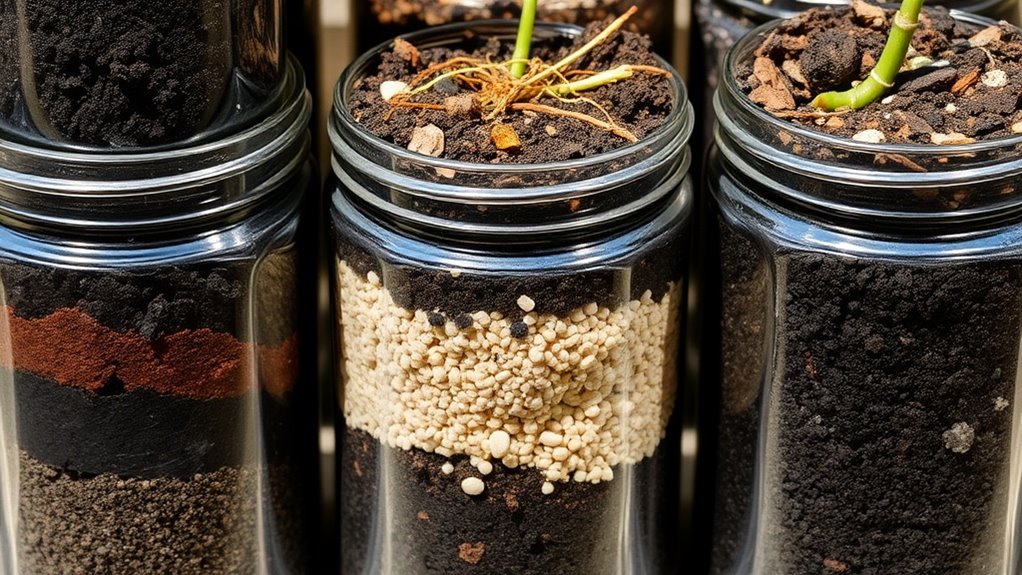These 6 Soil Tests Changed My Plant Game Forever
These six essential soil tests can truly revolutionize your gardening game. By testing pH levels, nutrient content, soil texture, organic matter, salinity, and microbial activity, you’ll pinpoint exactly what your plants need to thrive. Understanding soil pH informs adjustments for ideal growth, while nutrient analysis secures balanced fertilization. Evaluating texture and organic content helps promote moisture retention and structure. Salinity testing safeguards against harmful salt levels, and evaluating microbial activity enhances nutrient cycling. Discover how to effectively implement these tests for a thriving garden ecosystem.
Ph Level Testing
Testing the pH level of your soil is essential for understanding its acidity or alkalinity, which directly affects plant health.
Soil testing reveals whether your soil is acidic, neutral, or alkaline, guiding you in selecting appropriate plants and amendments.
Most plants thrive between a pH of 6.0 and 7.5, but some require more specific conditions.
By performing regular pH tests, you can monitor changes over time, ensuring your soil remains conducive to growth.
Adjustments, like adding lime to raise pH or sulfur to lower it, can optimize the environment for your plants, enhancing their nutrient uptake and overall health. Additionally, understanding soil testing methods can further aid in diagnosing any underlying issues affecting your garden’s success.
Nutrient Content Analysis
Understanding nutrient content is essential for ideal plant growth, as essential nutrients directly affect health and yield. You’ll want to explore various testing methods that accurately assess these nutrients in your soil. Once you have your soil test results, interpreting them correctly will guide your fertilization strategies effectively. Additionally, knowing your soil’s nutrient profile can help you prevent costly gardening mistakes, ensuring your plants thrive and yield abundantly.
Essential Nutrients for Plants
Essential nutrients play a key role in plant health and growth, directly influencing their ability to thrive in various environments.
Key nutrients include nitrogen, phosphorus, and potassium, essential for processes like photosynthesis, root development, and flowering.
Micronutrients like iron, manganese, and zinc, though needed in smaller amounts, are equally important for enzyme function and overall plant vitality.
A balanced nutrient profile guarantees ideal growth, enhances disease resistance, and improves yield quality.
Testing Methods Explained
How do you determine the nutrient content of your soil?
Start with a soil test kit or send a sample to a lab for a thorough analysis.
Most tests measure macronutrients like nitrogen, phosphorus, and potassium, as well as micronutrients such as iron and zinc.
The extraction method, commonly using a chemical solution, helps quantify nutrient availability.
pH levels are also assessed, as they influence nutrient uptake.
Additionally, consider testing for organic matter content, which supports soil health.
Each method provides valuable insights, allowing you to make informed decisions about amendments and fertilization tailored to your plants’ specific needs.
Interpreting Soil Test Results
Once you’ve obtained your soil test results, interpreting them accurately is key to optimizing your garden’s health.
Focus on the macronutrients: nitrogen, phosphorus, and potassium.
Each nutrient plays a specific role; for instance, nitrogen promotes leafy growth, while phosphorus supports root development and flowering.
Check the pH level, as it affects nutrient availability—most plants thrive in a range of 6.0 to 7.0.
If any nutrients are deficient or excessive, adjust your fertilization strategy accordingly.
Additionally, consider soil texture and organic matter content, as these factors influence drainage and nutrient retention, ultimately shaping your garden’s success.
Soil Texture Assessment
Understanding soil texture is essential for effective plant growth, as it influences water retention, nutrient availability, and root development. You’ll find that identifying soil composition through various assessment methods helps you to tailor your gardening practices. Additionally, being aware of soil health indicators can further enhance your gardening success.
Identifying Soil Composition
A key step in evaluating soil texture is identifying the composition of your soil, which directly influences plant health and growth.
To do this, you can conduct a simple jar test by mixing soil with water and letting it settle.
Over time, sand, silt, and clay will separate, allowing you to measure their proportions.
Alternatively, a soil texture triangle can help you classify your soil type based on these proportions.
Understanding your soil’s composition enables you to tailor your amendments and irrigation practices effectively, ensuring ideal conditions for your plants to thrive and flourish.
Importance of Texture
Soil texture assessment plays an essential role in determining how well your plants will thrive in their environment.
Understanding texture helps you predict drainage, nutrient retention, and root development.
Here are four key aspects of soil texture:
- Clay: Holds moisture but drains poorly, affecting root oxygen.
- Silt: Offers a balanced moisture level, promoting healthy growth.
- Sand: Drains quickly, preventing waterlogging but may need frequent watering.
- Loam: Combines sand, silt, and clay for ideal nutrient and moisture balance.
Methods of Assessment
Various methods exist for determining soil texture, each providing valuable insights into the characteristics that influence plant growth.
The most common techniques include the feel method, which involves tactile assessment of soil particles, and the sedimentation method, where soil is mixed with water and settled to separate textures.
Additionally, the hydrometer method quantitatively measures soil particle sizes using fluid density.
These approaches allow you to categorize soil into sand, silt, and clay proportions, essential for understanding drainage, nutrient retention, and aeration.
Organic Matter Evaluation
Evaluating organic matter in your soil is essential for understanding its health and fertility.
Organic matter improves soil structure, water retention, and nutrient availability, making it crucial for robust plant growth. Additionally, incorporating kitchen scraps and garden waste into your compost can significantly enhance organic matter levels in your soil.
To assess organic matter, consider these steps:
- Visual Inspection: Look for dark, crumbly soil; a sign of healthy organic content.
- Texture Test: Squeeze a handful of moist soil—if it holds together, it likely contains good organic matter.
- Smell Test: A rich, earthy aroma indicates beneficial microbial activity.
- Laboratory Analysis: Send a sample for precise organic matter quantification, guiding your fertility management.
Salinity Testing
Evaluating salinity levels in your soil is critical for plant health, as high salinity can hinder water uptake and nutrient absorption.
To assess salinity, you can use a conductivity meter or a simple soil extraction method.
Take a soil sample, mix it with distilled water, and measure the electrical conductivity (EC).
A reading above 2 dS/m indicates potentially harmful salinity levels.
Regular testing helps you monitor changes and adjust your irrigation practices accordingly.
If salinity is high, consider leaching the soil with excess water or incorporating organic matter to improve drainage and reduce salt concentration, promoting healthier plant growth. Additionally, understanding universal soil prep methods can further enhance your soil’s overall quality and support thriving plants.
Microbial Activity Measurement
While managing salinity levels is important for plant health, evaluating microbial activity in your soil plays an essential role in fostering a productive environment. Understanding microbial dynamics can enhance nutrient availability and improve soil structure. One effective way to promote microbial health is through easy composting tips, which can provide a steady supply of organic matter for your soil.
Here are four key indicators of microbial activity to measure:
- Soil Respiration: Indicates microbial metabolism and activity levels.
- Microbial Biomass: Reflects the total living microbial population in the soil.
- Enzyme Activity: Measures the breakdown of organic matter and nutrient cycling.
- Diversity of Microbial Community: A diverse community enhances resilience and promotes plant health.
Assessing these factors guarantees ideal growing conditions.





